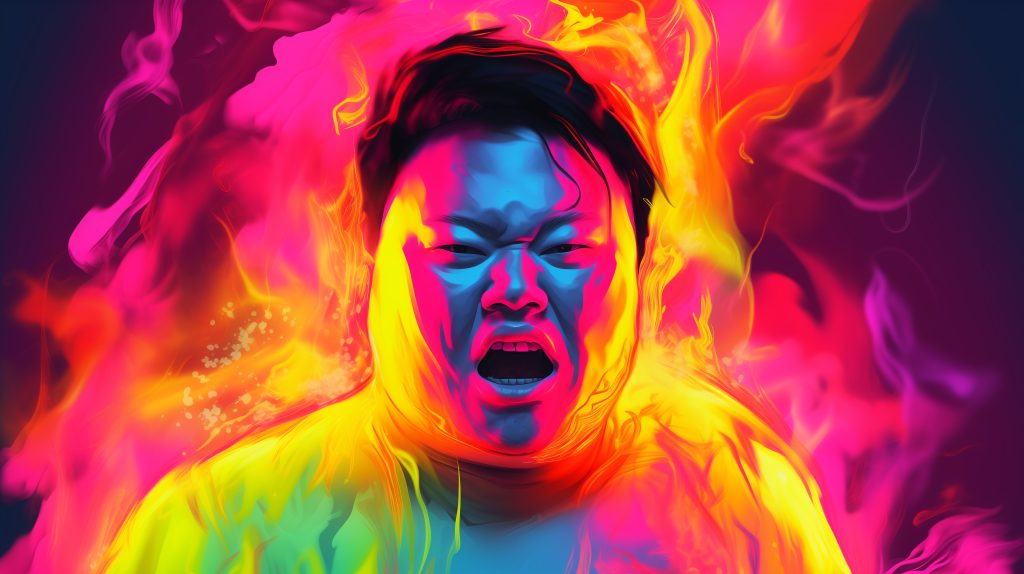Imagine fear as a chameleon, seamlessly blending into the colors that surround it, adapting and morphing with each shade it encounters. But have you ever stopped to ponder, what color truly embodies fear? It’s not just about the surface level symbolism; it’s about delving deeper into the intricate dance between hues and emotions. So, as you embark on this exploration of the chromatic spectrum of fear, be prepared to uncover the enigmatic power that colors wield over our deepest anxieties and apprehensions.
Cultural Perspectives on Fear
When examining cultural perspectives on fear, it becomes evident that colors play a significant role in shaping and expressing the shared emotions and beliefs within different societies. Fearful symbolism embedded in colors like black, gray, purple, and chartreuse showcases the intricate relationship between color perception and emotional responses. In various cultures, black symbolizes stark, gripping fear, often associated with sorrow, hopelessness, and evil, while gray conveys insecurity, anxiety, and impartiality. Purple, on the other hand, represents worry, agitation, and mystique, triggering instincts for self-preservation. Chartreuse, a blend of green and yellow, can signify cowardice and jealousy, impacting how fear is perceived. These symbolic representations vary across cultures, influenced by historical and societal norms, highlighting the deep-rooted connection between color and fear within different communities. By exploring the cultural influences on color associations, one can better understand how symbolic representations of fear are shaped and interpreted worldwide.
Emotional Impact of Black
Exploring the emotional impact of black reveals a profound connection between this color and the depths of fear and unease it can evoke in individuals.
- Psychological Impact: Black is often associated with stark, gripping fear, portraying emotions like sorrow, hopelessness, and evil.
- Cultural Influences: In Western cultures, black signifies death, while in folklore, it is used for supernatural creatures, further intensifying fear perceptions.
- Gray Symbolism in Anxiety: The color gray, standing between lightness and darkness, represents insecurity, anxiety, and phobia, painting a picture of subtle dread and fear of the unknown.
- Purple Associations with Fear: Purple, a mysterious and unsettling color, combines calmness with intensity, symbolizing conflict and the fear of hidden secrets.
- Chartreuse’s Unsettling Impressions: Chartreuse, with its unsettling mix of green and yellow, often whispers of something wrong or out of the ordinary, evoking caution and signaling potential dangers.
Understanding the emotional impact of black color delves deep into the roots of fear, influenced by psychological, cultural, and symbolic associations.
Gray: The Color of Anxiety
Gray, often standing between lightness and darkness, embodies the essence of anxiety as it symbolizes insecurity, fear, and phobia in a subtle yet profound manner. Gray is a color that holds a unique place in the spectrum, representing a blend of conflicting emotions and uncertainties. Its symbolism encompasses a range of fearful connotations, making it a powerful representation of anxiety. The association of gray with insecurity and phobia speaks to the deep emotional implications it carries. This color is not just a neutral tone but a reflection of inner turmoil and unease, evoking feelings of ambiguity and restlessness. Gray’s uncertainty association mirrors the complex nature of anxiety, often leaving individuals feeling trapped in a cycle of doubt and fear. Its subtle yet pervasive presence can induce a sense of foreboding and discomfort, capturing the essence of anxiety in a way that words sometimes cannot express.
Purple and Fear Associations
In the realm of color psychology, purple holds a unique position when it comes to associations with fear. Purple symbolism intertwines with fear perception in intriguing ways. Here are some insights into the cultural fear associations and the purple significance:
- Purple hue can evoke an emotional fear response due to its mysterious and unsettling nature.
- Purple color psychology suggests that lighter shades of purple can indicate fear, worry, and agitation.
- Purple is considered exotic and mystical, representing conflict and the fear of hidden secrets.
- The fearful connotations of purple imagery make it a polarizing color, often loved or hated with little middle ground.
- The purple hue is known to be used to trigger instincts for self-preservation, adding layers to its complex relationship with fear.
These aspects highlight how purple’s unique characteristics can evoke a range of emotions, including fear, making it a color worth exploring in the context of fear perception.
Chartreuse: Fearful Impressions
When considering the color chartreuse in the context of fear, its unsettling mix of green and yellow creates a distinct impression that whispers of something wrong or out of the ordinary. This eerie combination can evoke fearful impressions and caution signals, often resembling a toxic warning sign. The danger sparks associated with chartreuse stem from its ability to appear almost hazardous, like a color that should be approached with care.
| Fearful Impressions | Caution Signals | Danger Sparks |
|---|---|---|
| Unsettling mix of green and yellow | Resembles toxic warning signs | Evokes a sense of hazard |
| Whispers of something wrong or out of the ordinary | Induces careful approach | Sparks feelings of caution |
| Creates a distinct impression of unease | Signifies potential danger | Triggers alertness and wariness |
Chartreuse, with its peculiar blend of hues, plays on our subconscious associations with danger and alerts our senses to potential threats. In the realm of colors representing fear, chartreuse stands out as a unique and potent symbol of unease.
Red: Symbol of Danger
Considering the unsettling mix of chartreuse and its ability to evoke caution signals and fearful impressions, the focus now shifts to exploring the color red as a symbol of imminent danger. When it comes to red, it is more than just a color; it’s a red alert that demands your attention, sparking a fear factor that triggers a primal response. Here are some key points to help you understand the significance of red in symbolizing danger:
- Red Alert: This color serves as a critical warning, signaling immediate threats.
- Fear Factor: Red is like a panic button, igniting heightened alertness and a sense of urgency.
- Panic Button: It operates as a danger zone, demanding caution and careful navigation.
- Danger Zone: Red is synonymous with danger, evoking feelings of fear and trepidation.
- Critical Warning: It acts as a beacon of warning, symbolizing the need for swift and cautious action.
In essence, the color red is deeply ingrained in our psyche as a universal symbol of caution and danger, playing a crucial role in evoking fear and signaling potential harm.
Fear in Art and Design
Amidst the diverse ways fear is expressed, the incorporation of fear into the realms of art and design serves as a compelling exploration of human emotions. Fearful symbolism is often portrayed through artistic interpretations, utilizing color psychology to evoke emotional responses. In art, the color black is a dominant symbol of fear, representing the unknown, uncertainty, and death. It creates a sense of suspense and foreboding, drawing viewers into a world of darkness and trepidation. Gray, on the other hand, embodies ambiguity and uncertainty, symbolizing subtle dread and the fear of monotony. Its suffocating feeling of endlessness can provoke discomfort and unease. Purple, with its mysterious and unsettling nature, combines calmness with intensity, representing conflict and the fear of hidden secrets. Design implications of these colors play a crucial role in conveying fear effectively, impacting how individuals engage with art and design on an emotional level.
The Psychology of Fear Colors
The examination of fear colors in psychology delves into the intricate relationship between color symbolism and emotional responses, particularly in the context of fear representations in art and design.
- Color Symbolism: Different colors symbolize varying degrees of fear, from stark black to unsettling chartreuse.
- Fear Perception: Colors like red and gray evoke immediate threats and subtle dread, influencing how fear is perceived.
- Emotional Responses: Specific colors trigger emotional reactions, such as purple for mystery and conflict, impacting how fear is felt.
- Cultural Influences: Cultural backgrounds influence color associations with fear, shaping individuals’ responses to different hues.
- Color Associations: Colors like black and red are commonly associated with fear due to their historical and psychological implications.
Understanding the psychology of fear colors provides insight into how color choices in art and design can elicit specific emotional responses, tapping into universal and culturally influenced fears to create impactful visual experiences.

